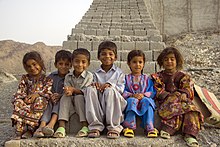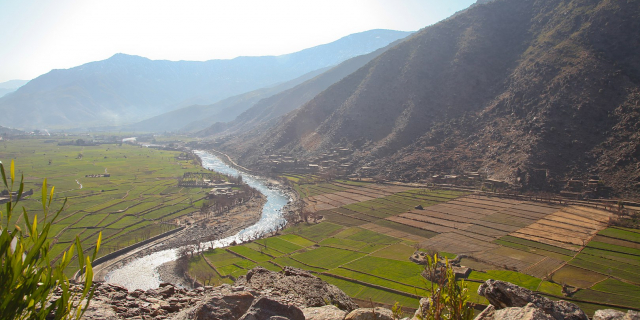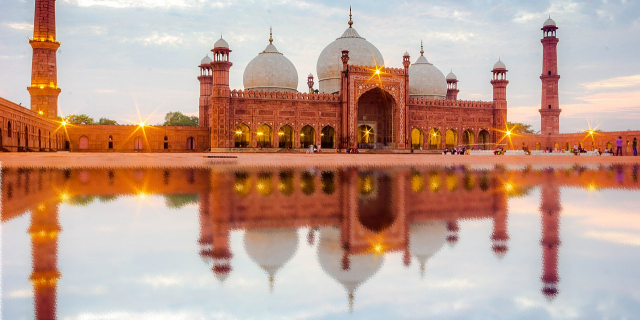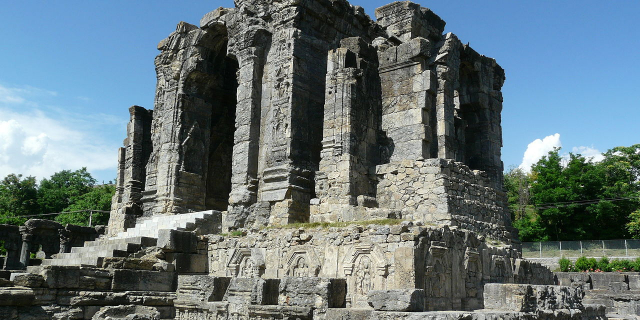Balochistan
Context of Balochistan
Balochistan ( bə-LOTCH-ist-a(h)n, -A(H)N; Urdu: بلوچستان; also romanised as Baluchistan and Baluchestan) is a historical region in Western and South Asia, located in the Iranian plateau's far southeast and bordering the Indian Plate and the Arabian Sea coastline. This arid region of desert and mountains is primarily populated by ethnic Baloch people.
The Balochistan region is split between three countries: Iran, Afghanistan and Pakistan. Administratively it comprises the Pakistani province of Balochistan, the Iranian province of Sistan and Baluchestan, and the southern areas of Afghanistan, which include Nimruz, Helmand and Kandahar provinces. It borders the Pashtunistan region to the north, Sindh and Punjab to the east, and Iranian regions to the west. Its southern coastline, including the Makran Coast, is washed by the Arabian Sea, in...Read more
Balochistan ( bə-LOTCH-ist-a(h)n, -A(H)N; Urdu: بلوچستان; also romanised as Baluchistan and Baluchestan) is a historical region in Western and South Asia, located in the Iranian plateau's far southeast and bordering the Indian Plate and the Arabian Sea coastline. This arid region of desert and mountains is primarily populated by ethnic Baloch people.
The Balochistan region is split between three countries: Iran, Afghanistan and Pakistan. Administratively it comprises the Pakistani province of Balochistan, the Iranian province of Sistan and Baluchestan, and the southern areas of Afghanistan, which include Nimruz, Helmand and Kandahar provinces. It borders the Pashtunistan region to the north, Sindh and Punjab to the east, and Iranian regions to the west. Its southern coastline, including the Makran Coast, is washed by the Arabian Sea, in particular by its western part, the Gulf of Oman.
More about Balochistan
- Population 19000000
 Large Baluch carpet, from the mid 19th century. Alternating rows depict cypress trees and Turkmen Gül motifs in offset coloration. The somber background colors are characteristic of Baluch weavings. This likely was a commission for a tribal Khan or chieftain for ceremonial use.
Large Baluch carpet, from the mid 19th century. Alternating rows depict cypress trees and Turkmen Gül motifs in offset coloration. The somber background colors are characteristic of Baluch weavings. This likely was a commission for a tribal Khan or chieftain for ceremonial use.The earliest evidence of human occupation in what is now Balochistan is dated to the Paleolithic era, represented by hunting camps and lithic scatter, chipped and flaked stone tools. The earliest settled villages in the region date to the ceramic Neolithic (c. 7000–6000 BCE) and included the site of Mehrgarh in the Kachi Plain. These villages expanded in size during the subsequent Chalcolithic when interaction was amplified. This involved the movement of finished goods and raw materials, including chank shell, lapis lazuli, turquoise, and ceramics. By 2500 BCE (the Bronze Age), the region now known as Pakistani Balochistan had become part of the Harappan cultural orbit,[1] providing key resources to the expansive settlements of the Indus river basin to the east.
...Read moreRead less Large Baluch carpet, from the mid 19th century. Alternating rows depict cypress trees and Turkmen Gül motifs in offset coloration. The somber background colors are characteristic of Baluch weavings. This likely was a commission for a tribal Khan or chieftain for ceremonial use.
Large Baluch carpet, from the mid 19th century. Alternating rows depict cypress trees and Turkmen Gül motifs in offset coloration. The somber background colors are characteristic of Baluch weavings. This likely was a commission for a tribal Khan or chieftain for ceremonial use.The earliest evidence of human occupation in what is now Balochistan is dated to the Paleolithic era, represented by hunting camps and lithic scatter, chipped and flaked stone tools. The earliest settled villages in the region date to the ceramic Neolithic (c. 7000–6000 BCE) and included the site of Mehrgarh in the Kachi Plain. These villages expanded in size during the subsequent Chalcolithic when interaction was amplified. This involved the movement of finished goods and raw materials, including chank shell, lapis lazuli, turquoise, and ceramics. By 2500 BCE (the Bronze Age), the region now known as Pakistani Balochistan had become part of the Harappan cultural orbit,[1] providing key resources to the expansive settlements of the Indus river basin to the east.
Classical periodFrom the 1st century to the 3rd century CE, the region was ruled by the Pāratarājas (lit. "Pārata Kings"), a dynasty of Indo-Parthian kings. The dynasty of the Pāratas is thought to be identical with the Pāradas of the Mahabharata, the Puranas and other Vedic and Iranian sources.[2] The Parata kings are primarily known through their coins, which typically exhibit the bust of the ruler (with long hair in a headband) on the obverse, and a swastika within a circular legend on the reverse, written in Brahmi (usually silver coins) or Kharoshthi (copper coins). These coins are mainly found in Loralai in today's western Pakistan.
During the wars between Alexander the Great (356-323 BC) and Emperor Darius III (336-330 BC), the Baloch were allied with the last Achaemenid emperor. According to Shustheri (1925), Darius III, after much hesitation, assembled an army at Arbela to counter the army of invading Greeks. His cousin Besius was the commander, leading the horsemen from Balkh. Berzanthis was the commander of the Baloch forces, Okeshthra was the commander of the forces from Khuzistan, Maseus was the commander of the Syrian and Egyptian contingent, Ozbed was the commander of the Medes, and Phirthaphirna was leading the Sakas and forces from Tabaristan, Gurgan, and Khurasan. Obviously, as part of a losing side, the Baloch certainly got their share of punishment from the victorious Macedonian forces.[3]
Herodotus in 450 BCE described the Paraitakenoi as a tribe ruled by Deiokes, a Persian king, in northwestern Persia (History I.101). Arrian describes how Alexander the Great encountered the Pareitakai in Bactria and Sogdiana, and had them conquered by Craterus (Anabasis Alexandrou IV). The Periplus of the Erythraean Sea (1st century CE) describes the territory of the Paradon beyond the Ommanitic region, on the coast of modern Balochistan.[4]
Medieval periodDuring the reign of Arab dynasties, the medieval Iran suffered the onslaught of Ghaznavids, Mongols, Timurids, and the incursions of Guzz Turks. The relationship between the Baloch and nearly all these powers were hostile, and the Baloch suffered enormously during this long period. The Baloch encounters with these powers and the subsequent Baloch miseries forced the Baloch tribes to move from the areas of conflicts and to settle in the farflung and inaccessible regions. The bloody conflicts with Buyids and Seljuqs were instrumental in waves of migration by the Baloch tribes from Kerman to further east.[5]
The Hindu Sewa Dynasty ruled parts of Balochistan, chiefly Kalat.[6][7] The Sibi Division, which was carved out of Quetta Division and Kalat Division in 1974, derives its name from Rani Sewi, the queen of the Sewa dynasty.[8]
 Map of independent Balochistan under the Buledi dynasty and the Kalat Khanate in 1730.
Map of independent Balochistan under the Buledi dynasty and the Kalat Khanate in 1730.The region was fully Islamized by the 9th century and became part of the territory of the Saffarids of Zaranj, followed by the Ghaznavids, then the Ghorids. The relation between the Ghaznavids and the Baloch had never been peaceful. Turan and Makuran came under the Ghaznavids founder Sebuktegin's suzerainty as early as AD 976-977 (Bosworth, 1963). The Baloch tribes fought against Sebuktegin when he attacked Khuzdar in AD 994. The Baloch were in the army of Saffarids Amir Khalaf and fought against Mahmud when the Ghaznavids forces invaded Sistan in AD 1013 (Muir, 1924). Many other occasions were mentioned by the historians of the Ghaznavids era in which the Baloch came into confrontation with the Ghaznavids forces (Nizam al-Mulk, 1960).[9]
There are only passing references of Baloch encounters with the Mongol hordes. In one of the classical Balochi ballads, there is mention of a Baloch chieftain, Shah Baloch, who, no doubt, heroically resisted a Mongol advance somewhere in Sistan.[10]
During the long period of en masse migrations, the Baloch were traveling through settled territories, and it could not have been possible to survive simply as wandering nomads. Perpetual migrations, hostile attitudes of other tribes and rulers, and adverse climactic conditions ruined much of their cattle breeding. Settled agriculture became a necessity for the survival of herds and an increased population. They began to combine settled agriculture with animal husbandry. The Baloch tribes now consisted of sedentary and nomadic population, a composition that remained an established feature of the Baloch tribes until recently.[11]
Ahmad Shah Durrani made it part of the Afghan Durrani Empire in 1749. In 1758 the Khan of Kalat, Mir Noori Naseer Khan Baloch, revolted against Ahmed Shah Durrani, defeated him, and freed most of today's Balochistan region from the Durrani Empire.[12][13][14][15]
Tribalism and nomadismBaloch tribalism in medieval times was synonymous with pastoral nomadism. Nomadic people, as observed by Heape (1931), regard themselves as the superior of sedentary or agriculturist. It is, perhaps, because the occupation of nomads made them strong, active, and inured to hardship and the dangers which beset a mobile life.[16]
The areas of Balochistan where the Baloch tribes moved in had a sedentary population, and the Baloch tribes were compelled to deal with their sedentary neighbors. Being in a weaker position, the Baloch tribes were in need of constant vigils for their survival in new lands. To deal with this problem, they began to make alliances and organized themselves into a more structured way. The structural solution to this problem was to create tribal confederacies or unions. Thus, in conditions of insecurity and disorder or when threatened by a predatory regional authority or a hostile central government, several tribal communities would form a cluster around a chief who had demonstrated his ability to offer protection and security.[16]
British occupationThe British took over the area[which?] in 1839.[17]
In the 1870s, Baluchistan came under control of the British Indian Empire in colonial India.[18] The fundamental objective of the British to enter into a treaty agreement with the Khanate of Kalat was to provide a passage and supplies to the "Army of Indus" on its way to Kandahar through Shikarpur, Jacobabad (Khangadh), Dhadar, Bolan Pass, Quetta, and Khojak Pass. It is interesting to note that the British imperialist interests in Balochistan were not primarily economic as was the case with other regions of India. Rather, it was of a military and geopolitical nature. Their basic objective in their advent in Balochistan was to station garrisons so as to defend the frontiers of British India from any threat coming from Iran and Afghanistan.[17]
Beginning from 1840, there began a general insurrection against the British rule throughout Balochistan. The Baloch were not ready to accept their country as part of an occupied Afghanistan and to be ruled under a puppet Khan. The powerful Mari tribe rose in total revolt. The British retaliated with excessive force, and a British contingent under the command of Major Brown on May 11, 1840, attacked the Mari headquarter of Kahan and occupied Kahan Fort and the surrounding areas (Masson, 1974). The Mari forces withdrew from the area, regrouped, and in an ambush wiped out a whole convoy of British troops near Filiji, killing more than one hundred British troops.[17]
During the time of the Indian independence movement, "three pro-Congress parties were still active in Balochistan's politics", such as the Anjuman-i-Watan Baluchistan, which favoured a united India and opposed its partition.[19][20]
Post-colonial historyThis section needs expansion. You can help by adding to it. (February 2023)In 2021, there was an earthquake that killed dozens of people. This came to be known as the 2021 Balochistan earthquake. There were other major earthquakes in 2013 (2013 Balochistan earthquake and 2013 Saravan earthquake).
 Baloch children photographed in Ashkutu, Iran, in March 2017^ Doshi, Riddhi (17 May 2015). "What did Harappans eat, how did they look? Haryana has the answers". Hindustan Times. Archived from the original on May 17, 2015. ^ Tandon 2006, p. 183. ^ "Encyclopedia Britannica | Britannica". www.britannica.com. Retrieved 2022-04-21. ^ Tandon 2006, pp. 201–202. ^ Pillalamarri, Akhilesh. "A Brief History of Balochistan". thediplomat.com. Retrieved 2022-04-21. ^ Fowle, T. C.; Rai, Diwan Jamiat (1923). Baluchistan. Directorate of Archives, Government of Balochistan. p. 100. The Hindus of Kalat town may indeed be far more indigenous since they claim descent from the ancient Sewa dynasty that ruled Kalat long before the Brahui came to Baluchistan. ^ Balochistan Through the Ages: Geography and history. Nisa Traders. 1979. p. 316. The country up to and including Multan was conquered by the Arabs and the Hindu dynasty of Sind and probably also the Sewa dynasty of Kalat came to an end. ^ Quddus, Syed Abdul (1990). The Tribal Baluchistan. Ferozsons. p. 49. ISBN 978-969-0-10047-4. The Sibi division was carved out of the Quetta and Kalat Divisions in April, 1974, and comprises districts of Sibi, Kachhi, Nasirabad, Kohlu and Dera Bugti. The Division derives its name from the town of Sibi or Sewi. The local tradition attributes the origin of this name to Rani Sewi of the Sewa dynasty which ruled this part of the country in ancient times. ^ "The Regions of Sind, Baluchistan, Multan and Kashmir: the Historical, Social and Economic Setting | Programme des Routes de la Soie". fr.unesco.org. Retrieved 2022-04-21. ^ "GlobalSecurity.org". www.globalsecurity.org. Retrieved 2022-04-21. ^ "Engaged review of contemporary art and thought". www.nakedpunch.com. Retrieved 2022-04-21. ^ "Ahmad Shah and the Durrani Empire". Library of Congress Country Studies on Afghanistan. 1997. Retrieved 23 September 2010. ^ Friedrich Engels (1857). "Afghanistan". Andy Blunden. The New American Cyclopaedia, Vol. I. Archived from the original on 18 October 2010. Retrieved 23 September 2010. Afghanistan ... an extensive country of Asia ...between Persia and the Indies, and in the other direction between the Hindu Kush and the Indian Ocean. It formerly included the Persian provinces of Khorassan and Kohistan, together with Herat, Beluchistan, Cashmere, and Sinde, and a considerable part of the Punjab ... Its principal cities are Kabul, the capital, Ghuznee, Peshawer, and Kandahar ^ "Aḥmad Shah Durrānī". Encyclopædia Britannica. 2010. Retrieved 25 August 2010. ^ Clements, Frank (2003). Conflict in Afghanistan: a historical encyclopedia. ABC-CLIO. p. 81. ISBN 978-1-85109-402-8. Retrieved 23 September 2010. ^ a b "Gale - Institution Finder". galeapps.gale.com. Retrieved 2022-04-21. ^ a b c "History – Government of Balochistan". Retrieved 2022-04-21. ^ Henige, David P. (1970). Colonial Governors from the Fifteenth Century to the Present: A Comprehensive List. University of Wisconsin Press. p. 89. ISBN 9780299054403. The British began to assume control over the rough desert region in extreme western India known as Baluchistan in the 1870s. ^ Afzal, M. Rafique (2001). Pakistan: History and Politics 1947-1971. Oxford University Press. p. 40. ISBN 978-0-19-579634-6. Besides the Balochistan Muslim League, three pro-Congress parties were still active in Balochistan's politics: the Anjuman-i Watan, the Jamiatul Ulama u Hind, and the Qalat State National Party. ^ Ranjan, Amit (2018). Partition of India: Postcolonial Legacies. Taylor & Francis. ISBN 9780429750526. Furthermore, Congress leadership of Balochistan was united and there was no disagreement over its president, Samad Khan Achakzai. On the other hand, Qazi Isa was the president of the League in Balochistan. Surprisingly, he was neither a Balochi nor a Sardar. Consequently, all Sardars except Jaffar Khan Jamali, were against Qazi Isa for contesting this seat.
Baloch children photographed in Ashkutu, Iran, in March 2017^ Doshi, Riddhi (17 May 2015). "What did Harappans eat, how did they look? Haryana has the answers". Hindustan Times. Archived from the original on May 17, 2015. ^ Tandon 2006, p. 183. ^ "Encyclopedia Britannica | Britannica". www.britannica.com. Retrieved 2022-04-21. ^ Tandon 2006, pp. 201–202. ^ Pillalamarri, Akhilesh. "A Brief History of Balochistan". thediplomat.com. Retrieved 2022-04-21. ^ Fowle, T. C.; Rai, Diwan Jamiat (1923). Baluchistan. Directorate of Archives, Government of Balochistan. p. 100. The Hindus of Kalat town may indeed be far more indigenous since they claim descent from the ancient Sewa dynasty that ruled Kalat long before the Brahui came to Baluchistan. ^ Balochistan Through the Ages: Geography and history. Nisa Traders. 1979. p. 316. The country up to and including Multan was conquered by the Arabs and the Hindu dynasty of Sind and probably also the Sewa dynasty of Kalat came to an end. ^ Quddus, Syed Abdul (1990). The Tribal Baluchistan. Ferozsons. p. 49. ISBN 978-969-0-10047-4. The Sibi division was carved out of the Quetta and Kalat Divisions in April, 1974, and comprises districts of Sibi, Kachhi, Nasirabad, Kohlu and Dera Bugti. The Division derives its name from the town of Sibi or Sewi. The local tradition attributes the origin of this name to Rani Sewi of the Sewa dynasty which ruled this part of the country in ancient times. ^ "The Regions of Sind, Baluchistan, Multan and Kashmir: the Historical, Social and Economic Setting | Programme des Routes de la Soie". fr.unesco.org. Retrieved 2022-04-21. ^ "GlobalSecurity.org". www.globalsecurity.org. Retrieved 2022-04-21. ^ "Engaged review of contemporary art and thought". www.nakedpunch.com. Retrieved 2022-04-21. ^ "Ahmad Shah and the Durrani Empire". Library of Congress Country Studies on Afghanistan. 1997. Retrieved 23 September 2010. ^ Friedrich Engels (1857). "Afghanistan". Andy Blunden. The New American Cyclopaedia, Vol. I. Archived from the original on 18 October 2010. Retrieved 23 September 2010. Afghanistan ... an extensive country of Asia ...between Persia and the Indies, and in the other direction between the Hindu Kush and the Indian Ocean. It formerly included the Persian provinces of Khorassan and Kohistan, together with Herat, Beluchistan, Cashmere, and Sinde, and a considerable part of the Punjab ... Its principal cities are Kabul, the capital, Ghuznee, Peshawer, and Kandahar ^ "Aḥmad Shah Durrānī". Encyclopædia Britannica. 2010. Retrieved 25 August 2010. ^ Clements, Frank (2003). Conflict in Afghanistan: a historical encyclopedia. ABC-CLIO. p. 81. ISBN 978-1-85109-402-8. Retrieved 23 September 2010. ^ a b "Gale - Institution Finder". galeapps.gale.com. Retrieved 2022-04-21. ^ a b c "History – Government of Balochistan". Retrieved 2022-04-21. ^ Henige, David P. (1970). Colonial Governors from the Fifteenth Century to the Present: A Comprehensive List. University of Wisconsin Press. p. 89. ISBN 9780299054403. The British began to assume control over the rough desert region in extreme western India known as Baluchistan in the 1870s. ^ Afzal, M. Rafique (2001). Pakistan: History and Politics 1947-1971. Oxford University Press. p. 40. ISBN 978-0-19-579634-6. Besides the Balochistan Muslim League, three pro-Congress parties were still active in Balochistan's politics: the Anjuman-i Watan, the Jamiatul Ulama u Hind, and the Qalat State National Party. ^ Ranjan, Amit (2018). Partition of India: Postcolonial Legacies. Taylor & Francis. ISBN 9780429750526. Furthermore, Congress leadership of Balochistan was united and there was no disagreement over its president, Samad Khan Achakzai. On the other hand, Qazi Isa was the president of the League in Balochistan. Surprisingly, he was neither a Balochi nor a Sardar. Consequently, all Sardars except Jaffar Khan Jamali, were against Qazi Isa for contesting this seat.
- Stay safe
The situation in the province is far from stable. Outbursts of politically motivated violence and civil disobedience are common, and things can deteriorate at any given time.
Avoid going near the Iranian border; it's incredibly risky and dangerous. In 2013, two women from the Czech Republic were kidnapped and held ransom despite having an armed escort.






































